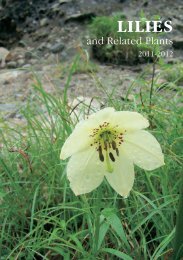LILIES - RHS Lily Group
LILIES - RHS Lily Group
LILIES - RHS Lily Group
Create successful ePaper yourself
Turn your PDF publications into a flip-book with our unique Google optimized e-Paper software.
Faced with this continuing situation, in 1978 Council decided that the<br />
Committee should become semi-independent and concerned more with the<br />
affairs of the <strong>Lily</strong> <strong>Group</strong>. It would loose its status as a Standing Committee and<br />
thus be free to elect its own Chairman, with the <strong>Lily</strong> <strong>Group</strong> or the Committee<br />
selecting its members. Gradually thereafter it became known in <strong>RHS</strong> records and<br />
publications as the <strong>RHS</strong> <strong>Lily</strong> <strong>Group</strong> Committee. Colonel Iain Ferguson became<br />
Chairman and was subsequently succeeded by Mrs Dee Martyn Simmons, a<br />
member of the Committee since 1966.<br />
It seems that the Committee, divested of the ties and privileges of Standing<br />
Committee status and without a real function failed, initially, to consolidate its new<br />
place in the Society. The succession of ten-yearly International <strong>Lily</strong> Conferences<br />
which had begun after the Second World War faltered in 1979 when lack of direction<br />
in the Committee led to postponement for a year and, eventually, abandonment.<br />
It is important to record here the part played in maintaining continuity during this<br />
uncertain period by members such as David Parsons, sometime Vice-Chairman, at<br />
that time growing lilies commercially, Derek Fox who also turned to the nursery<br />
trade, and Brian Halliwell, Assistant-Curator at the Royal Botanic Gardens, Kew.<br />
The beginnings of a new function in the Committee could already be seen in<br />
the minutes in 1976 with the first mention of the <strong>Lily</strong> <strong>Group</strong> seed distribution.<br />
Operated at first by the Secretary, James Platt, it subsequently, in the hands of Mrs<br />
Molly Pottinger, became established as an important factor in encouraging the<br />
growing of lilies and consolidating the <strong>Lily</strong> <strong>Group</strong>. Her successor, Alan Hooker,<br />
has succeeded in expanding the appeal of this function worldwide – both to the<br />
east as far as Japan and Australia, and westwards to Canada and the USA. The<br />
modern dominance of lily hybrids in the horticultural trade has meant that more<br />
hybrid seed has become available. At the same time the virtual disappearance<br />
of most lily species from catalogues led to an insatiable demand for their seed<br />
among amateurs determined to grow even the apparently ungrowable.<br />
In common with most small specialist organisations the <strong>Lily</strong> <strong>Group</strong> was not<br />
strong financially. In 1982 it received a gift from the well-known wild-life artist<br />
Raymond Booth, who is still a member today. As well as growing many lilies in<br />
his garden, Mr Booth delights in producing scientifically accurate studies of wild<br />
British plants and animals. His gift comprised a large and detailed portrait of<br />
Lilium auratum together with the copyright usually retained by the artist in such<br />
circumstances. Obviously the ownership of a painting is a mixed blessing for a<br />
corporate body without a permanent home and so it was sold, through a New<br />
Bond Street dealer, for a sum in excess of £3000.<br />
In terms of publications the recent history of the <strong>Lily</strong> Committee and the <strong>Lily</strong><br />
<strong>Group</strong> has been dominated by the enormous increase in costs and the consequent<br />
fall in demand. The Conference issue of the <strong>Lily</strong> Year Book in 1970 is still<br />
34




